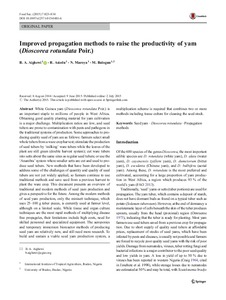| dc.contributor.author | Aighewi, B.A. |
| dc.contributor.author | Asiedu, Robert |
| dc.contributor.author | Maroya, N. |
| dc.contributor.author | Balogun, M. |
| dc.date.accessioned | 2019-12-04T10:57:56Z |
| dc.date.available | 2019-12-04T10:57:56Z |
| dc.date.issued | 2015 |
| dc.identifier.citation | Aighewi, B.A., Asiedu, R., Maroya, N., & Balogun, M. (2015). Improved propagation methods to raise the productivity of yam (Dioscorea rotundata Poir.). Food Security, 7(4), 823-834. |
| dc.identifier.issn | 1876-4517 |
| dc.identifier.uri | https://hdl.handle.net/20.500.12478/875 |
| dc.description.abstract | White Guinea yam (
Dioscorea rotundata
Poir.) is
an important staple to millions of people in West Africa.
Obtaining good quality planting material for yam cultivation
is a major challenge. Multiplication ratios are low, and seed
tubers are prone to contamination with pests and pathogens in
the traditional systems of production. Some approaches to pro-
ducing quality seed of yam are as follows: farmers select small
whole tubers from a ware crop harvest; stimulate the production
of seed tubers by
‘
milking
’
ware tubers while the leaves of the
plant are still green (double harvest system); cut ware tubers
into setts about the same sizes as regular seed tubers; or use the
‘
Anambra
’
system where smaller setts are cut and used to pro-
duce seed tubers. New methods that have been developed to
address some of the challenges of quantity and quality of seed
tubers are not yet widely applied, so farmers continue to use
traditional methods and save seed from a previous harvest to
plant the ware crop. This document presents an overview of
traditional and modern methods of seed yam production and
gives a perspective for the future. Among the modern methods
of seed yam production, only the minisett technique, which
uses 25
–
100 g tuber pieces, is currently used at farmer level,
although on a limited scale. While tissue and organ culture
techniques are the most rapid methods of multiplying disease
free propagules, their limitations include high costs, need for
skilled personnel and specialized equipment. The aeroponics
and temporary immersion bioreactor methods of producing
seed yam are relatively new, and still need more research. To
build and sustain a viable seed yam production system, aWhite Guinea yam (
Dioscorea rotundata
Poir.) is
an important staple to millions of people in West Africa.
Obtaining good quality planting material for yam cultivation
is a major challenge. Multiplication ratios are low, and seed
tubers are prone to contamination with pests and pathogens in
the traditional systems of production. Some approaches to pro-
ducing quality seed of yam are as follows: farmers select small
whole tubers from a ware crop harvest; stimulate the production
of seed tubers by
‘
milking
’
ware tubers while the leaves of the
plant are still green (double harvest system); cut ware tubers
into setts about the same sizes as regular seed tubers; or use the
‘
Anambra
’
system where smaller setts are cut and used to pro-
duce seed tubers. New methods that have been developed to
address some of the challenges of quantity and quality of seed
tubers are not yet widely applied, so farmers continue to use
traditional methods and save seed from a previous harvest to
plant the ware crop. This document presents an overview of
traditional and modern methods of seed yam production and
gives a perspective for the future. Among the modern methods
of seed yam production, only the minisett technique, which
uses 25
–
100 g tuber pieces, is currently used at farmer level,
although on a limited scale. While tissue and organ culture
techniques are the most rapid methods of multiplying disease
free propagules, their limitations include high costs, need for
skilled personnel and specialized equipment. The aeroponics
and temporary immersion bioreactor methods of producing
seed yam are relatively new, and still need more research. To
build and sustain a viable seed yam production system, a |
| dc.language.iso | en |
| dc.subject | Dioscorea |
| dc.subject | Genus |
| dc.subject | Yams |
| dc.subject | Guinea Yam |
| dc.title | Improved propagation methods to raise the productivity of yam (Dioscorea rotundata Poir.) |
| dc.type | Journal Article |
| dc.description.version | Peer Review |
| cg.contributor.crp | Roots, Tubers and Bananas |
| cg.contributor.affiliation | International Institute of Tropical Agriculture |
| cg.contributor.affiliation | University of Ibadan |
| cg.coverage.region | Africa |
| cg.coverage.region | West Africa |
| cg.coverage.country | Nigeria |
| cg.isijournal | ISI Journal |
| cg.authorship.types | CGIAR and developing countries institute |
| cg.iitasubject | Yam |
| cg.journal | Food Security |
| cg.howpublished | Formally Published |
| cg.accessibilitystatus | Limited Access |
| local.dspaceid | 76374 |
| cg.identifier.doi | https://dx.doi.org/10.1007/s12571-015-0481-6 |

